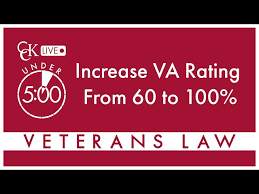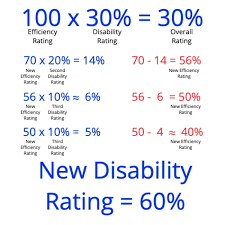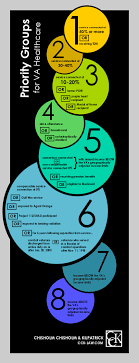Understanding 60 Percent Disability Rating from the VA
When it comes to veterans’ benefits, disability ratings play a crucial role in determining the level of compensation and support a veteran is eligible to receive. A 60 percent disability rating from the Department of Veterans Affairs (VA) signifies that a veteran has a moderate level of impairment due to a service-connected condition.
Receiving a 60 percent disability rating means that the VA has determined that the veteran’s service-connected condition significantly impacts their ability to function in daily life. This rating may entitle the veteran to various benefits, including monthly disability compensation, access to healthcare services, vocational rehabilitation, and more.
It is important for veterans with a 60 percent disability rating to understand their rights and options for receiving benefits. They may also be eligible for additional support services and resources to help them cope with their condition and improve their quality of life.
If you or someone you know has received a 60 percent disability rating from the VA, it is recommended to consult with a veterans’ benefits counselor or advocate to explore all available benefits and ensure that you are receiving the support you deserve.
Remember, each veteran’s situation is unique, and it is essential to seek personalized guidance to fully understand and maximize your benefits as a result of your disability rating.
Maximizing Your VA Benefits: 6 Essential Tips for Securing a 60 Percent Disability Rating
- Understand the criteria for qualifying for a 60 percent disability rating from the VA.
- Provide thorough documentation of your medical conditions and how they impact your daily life.
- Seek assistance from a Veterans Service Officer to help with your VA disability claim.
- Consider seeking a second opinion or additional medical evidence to support your claim.
- Be prepared for a potential appeals process if your initial claim is denied or rated lower than expected.
- Stay informed about updates and changes in VA disability benefits and regulations.
Understand the criteria for qualifying for a 60 percent disability rating from the VA.
To increase your chances of qualifying for a 60 percent disability rating from the VA, it is crucial to have a clear understanding of the criteria used for evaluation. The VA considers various factors, such as the severity of your service-connected condition and how it impacts your daily functioning, to determine the appropriate disability rating. By familiarizing yourself with these criteria and providing comprehensive documentation of your condition and its effects, you can better advocate for the rating that accurately reflects your level of impairment. Seeking guidance from a veterans’ benefits counselor or advocate can also help ensure that you meet the necessary requirements for a 60 percent disability rating and access the benefits you are entitled to receive.
Provide thorough documentation of your medical conditions and how they impact your daily life.
To increase your chances of receiving a 60 percent disability rating from the VA, it is crucial to provide thorough documentation of your medical conditions and clearly demonstrate how they affect your daily life. By detailing the symptoms, limitations, and challenges you face due to your service-connected condition, you can help the VA understand the full extent of your disability and make an accurate assessment of your disability rating. Be sure to include specific examples and details in your documentation to support your claim effectively.
Seek assistance from a Veterans Service Officer to help with your VA disability claim.
Seeking assistance from a Veterans Service Officer can greatly benefit veterans with a 60 percent disability rating in navigating the complexities of their VA disability claim. These officers are trained professionals who understand the intricacies of the VA system and can provide invaluable guidance and support throughout the claims process. By working with a Veterans Service Officer, veterans can ensure that their claim is accurately prepared, submitted on time, and advocated for effectively, increasing their chances of receiving the benefits they are entitled to.
Consider seeking a second opinion or additional medical evidence to support your claim.
When dealing with a 60 percent disability rating from the VA, it is advisable to consider seeking a second opinion or obtaining additional medical evidence to strengthen your claim. A second opinion from another qualified healthcare provider can provide valuable insights and potentially uncover aspects of your condition that were previously overlooked. Additionally, gathering supplementary medical evidence can help substantiate the severity and impact of your service-connected condition, increasing the likelihood of receiving the benefits and support you rightfully deserve. It is crucial to explore all avenues to ensure that your disability claim is accurately evaluated and appropriately compensated by the VA.
Be prepared for a potential appeals process if your initial claim is denied or rated lower than expected.
It is crucial to be prepared for a potential appeals process if your initial claim for a 60 percent disability rating from the VA is denied or rated lower than expected. Appeals are common in the VA disability claims process, and understanding the steps involved in appealing a decision can significantly increase your chances of a successful outcome. Seeking assistance from a veterans’ benefits counselor or advocate can provide valuable support and guidance throughout the appeals process, ensuring that you have the best chance of receiving the benefits you deserve.
Stay informed about updates and changes in VA disability benefits and regulations.
It is crucial for veterans with a 60 percent disability rating from the VA to stay informed about updates and changes in disability benefits and regulations. By staying up-to-date on any modifications to the benefits system, veterans can ensure they are aware of all available resources and support services that may be beneficial to them. Keeping abreast of these changes will help veterans make informed decisions about their benefits and maximize their access to the assistance they are entitled to receive.




